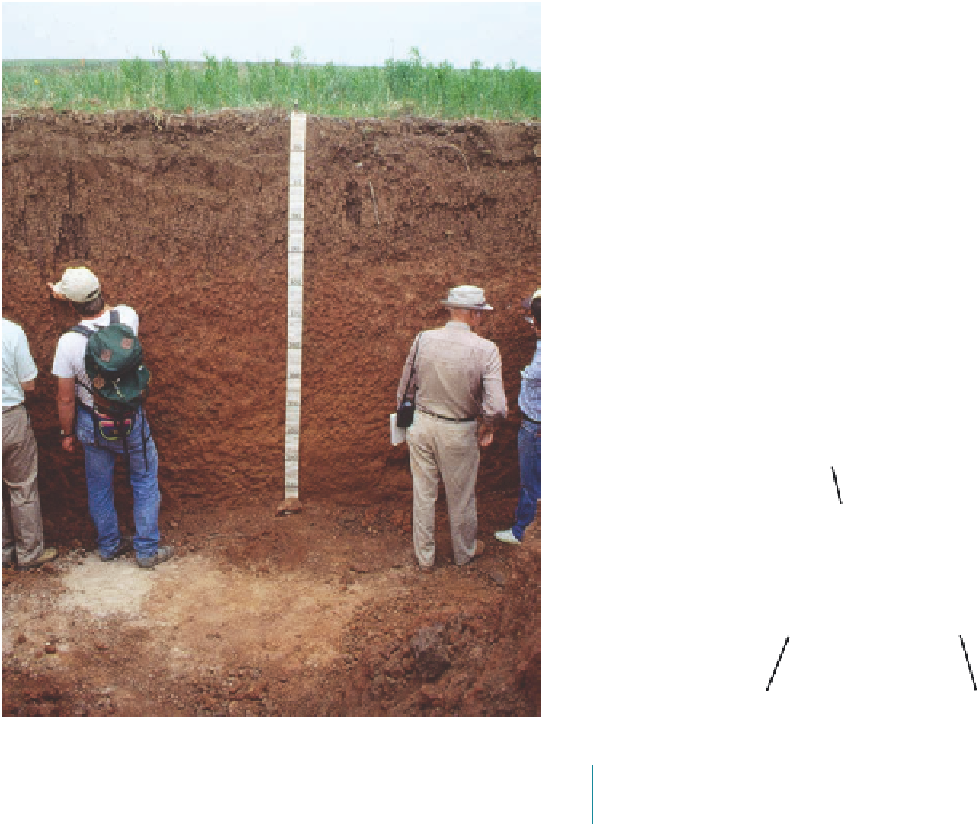Geoscience Reference
In-Depth Information
What Is Soil?
Although all soils can be viewed in these various ways, they nev-
ertheless vary dramatically in terms of their character and thick-
ness, ranging from a few centimeters to several meters in depth.
Soils are indeed one of our most important natural resources.
They are fundamental to life on Earth because of their interaction
with climate and vegetation. Soils provide plants with physical
support as well as nutrients and water for growth. Plants, in turn,
support soils by anchoring them to Earth. Without a vegetative cover,
soil is prone to erosion, which leads to reduced fertility for agricul-
ture and can contribute to famines in the world's poorest nations.
Did you ever play in the dirt as a child? Did you ever stop to
think about where the dirt had come from and how long it had
been there? Although you generally referred to the material as
“dirt,” in all probability you were playing in soil. You may won-
der what difference it makes whether it is called “dirt” or “soil”:
Are they not the same thing? In everyday language the two terms
can be used interchangeably, but in the context of physical geog-
raphy and soil science, the concepts are indeed very different.
The fact is that dirt is not necessarily soil, but soil
forms
in dirt.
Another way to look at it is that soil is what happens to dirt.
Soil
is the uppermost layer of the Earth's surface and con-
tains mineral and organic matter capable of supporting plants
(Figure 11.1). Another way to think about soil is that it is the
outermost rind of Earth, similar to how an orange peel is the
outermost part of the orange. Still another way to consider soil
is as the transition between the atmosphere and the rocky Earth.
Basic Soil Properties
The different variables that, taken together, comprise soil can be
generally classified into the following four groups (Figure 11.2).
1.
Inorganic materials
Inorganic materials are naturally
occurring chemical elements or compounds that possess
a crystalline structure. Each specific mineral (element
or compound) owes its structure to the particular rock
from which it came. Some of the most common miner-
als found in soil contain the elements silicon, aluminum,
iron, calcium, potassium, and magnesium. The element
calcium, for example, is part of the rock limestone. As
limestone disintegrates through a process called
weath-
ering
(discussed in Chapter 14), the minerals become
reduced in size enough for plants to use them as nutrients.
The key point for our present purposes is that, until the
plants absorb the minerals, they are stored in the soil.
2.
Organic matter
Organic matter forms from living and
decayed organisms and accumulates in the upper part of
soil. As plants and animals die and decay, bacteria and fungi
decompose their remains and produce
humus
, which is par-
tially decomposed organic matter. Humus has a sponge-like
quality that allows soil to hold water. In addition, humus
increases soil fertility because (a) it helps stabilize the soil
Organic matter (5%)
Pore spaces
(50%)
Mineral
matter (45%)
Includes water
and air
Includes ions and
parent materials
Figure 11.1 Analyzing soil in the field.
Soil scientists investi-
gating a soil profile in a backhoe trench. Understanding soils is an
important part of geography. Many geography students spend at
least some time doing “hands-on” work like this.
Figure 11.2 General composition of soil
Approximately 50%
of soil is mineral and organic matter. The remaining 50% consists
of pore spaces between grains. These spaces hold water and air.
Soil
The uppermost layer of the Earth's surface that forms by
the influence of parent material, climate, relief, and chemical
and biological agents.
Humus
Decomposed organic matter, typically dark, that is
contained within the soil.











